Exploiting Mobile Edge Computing for Enhancing Vehicular Applications in Smart Cities
Abstract
:1. Introduction
- First, we provide a review of the current efforts to integrate MEC in vehicular environments, with a classification of potential applications and a description of the associated challenges and issues for further research.
- Second, we propose an edge-based data dissemination protocol which addresses efficiency and scalability in vehicular networking environments. Our protocol accommodates the two major classes of vehicular networking applications: traffic safety and travel convenience.
- Third, we provide a simulation-based implementation for evaluating our protocol at the application level in comparison with existing approaches.
2. Literature Review
2.1. Enabling Technology
2.2. Architecture
2.2.1. The Traffic Sensing Layer
2.2.2. The Mobile Edge Computing Layer
2.2.3. The Remote Cloud Server Layer
2.3. Communication
2.4. Deployment
3. Potential Applications
- Connectivity: vehicles with no Internet connection can be supported with safety and convenience services on demand, by providing timely information through direct communication between the requesting vehicles and the nearest edge. In safety conditions, edges broadcast warning messages to vehicles within their coverage area. Moreover, vehicles can request the nearest edge for convenience service provision. The edge can connect to the Internet if necessary and provide a response to the requesting vehicles.
- Traffic Monitoring: Traffic events can be effectively detected by network edges with high accuracy according to monitored traffic conditions. Vehicles can be warned of a potential crash or a predicted congestion to take proper actions.
- Dissemination Efficiency: Due to the characteristics of proximity and communication coverage, network edges can provide efficient data dissemination with high delivery ratio and acceptable latency to relatively faraway distances.
- Trust Management: Edges have the potential to generate trusted safety and convenience messages in a context of trust management system, which can address many of the existing trust management in VANET.
- Enhanced privacy; since user data can be produced and consumed locally and anonymously without the need to store it or upload it to the cloud.
3.1. Data Collection, Dissemination and Analysis
3.2. Vehicular Control Systems
3.3. Traffic Management
3.4. Trust Management
4. The Proposed Protocol
4.1. A Protocol Overview
4.2. Problem Description
4.3. Traffic Condtion Detection and Representation
4.4. Delay-Controlled Data Dissemination
4.5. The Integration in Delay-Tolerant Applications
5. Performance Evaluation
5.1. Dissemination Protocols
- Enhanced Slotted 1-Persistance (ES1P): which is an enhanced version of the well-known Slotted 1-Persistance [40]. The enhancement is achieved by integrating the same suppression mechanism utilized in our methodology to accommodate urban vehicular environment. ES1P does not utilize traffic condition information to control the broadcast. Instead, it considers a predefined number of timeslots for setting the broadcasting delays of the receiving vehicles.
- TURBO: which is a representative example of the recent beacon-based protocols for VANETs [15]. In contrast, our methodology and ES1P utilize beacon-free data dissemination.
- ES1P-MEC: which presents the performance of ES1P with the aid of MEC.
- TURBO-MEC: which presents the performance of TURBO with the aid of MEC.
5.2. Performance Metrics
- Data Delivery Ratio (DR); which measures the percentage of coverage. For full coverage, every vehicle should receive a copy of any sent message. At the end of the simulation, the number of messages that should be received is equal to the number of vehicles that exist whenever a message is sent, which we refer to as expected messages Mexp. For every message i, DR is obtained by dividing the number of successfully received copies of the message Mrcv by Mexp. Assuming a total of sent messages Msent, DR is computed as:
- Broadcast Overhead (BO); which measures the average broadcast overhead per message reported by an arbitrary vehicle j, which is obtained by dividing the total number of duplicate messages Mdup, by the number of uniquely identified messages received Mrcv. Assuming N vehicles contributing in data dissemination, the global BO is computed as:
- Dissemination Delay (DD); which considers all reported delays whenever a new message is received by a vehicle to estimate an average delay for any vehicle to receive a new message. Whenever a new message i is received, the local delay is reported by computing the difference between the message arrival time tm and the message creation time t0 (which is stored in the message Timestamp field). Assuming the total of received messages Mrcv at the end of the simulation, reported local delays are considered for computing the global average delay as follows:
5.3. Simulation Setup
5.4. Simulation Results
6. Issues and Challenges
6.1. Deployment
6.2. Programmability
6.3. Quality of Service
6.4. Privacy and Security
7. Conclusions
Author Contributions
Funding
Conflicts of Interest
References
- Liu, J.; Wan, J.; Jia, D.; Zeng, B.; Li, D.; Hsu, C.H.; Chen, H. High-Efficiency Urban Traffic Management in Context-Aware Computing and 5G Communication. IEEE Commun. Mag. 2017, 55, 34–40. [Google Scholar] [CrossRef]
- Gerla, M. Vehicular cloud computing. In Proceedings of the 11th Annual Mediterranean Ad Hoc Networking Workshop (Med-Hoc-Net), Ayia Napa, Cyprus, 19–22 June 2012; pp. 152–155. [Google Scholar]
- Ahmed, A.; Ahmed, E. A survey on mobile edge computing. In Proceedings of the 10th International Conference on Intelligent Systems and Control (ISCO), Coimbatore, India, 7–8 January 2016; pp. 1–8. [Google Scholar]
- O’Donnell, B. The Future of Advanced-Edge Computing Is Actually in Autonomous Cars. 2017. Available online: http://www.recode.net/2017/3/14/14924892/autonomous-car-self-driving-cloud-fog-advanced-edge-computing (accessed on 30 March 2017).
- He, X.; Ren, Z.; Shi, C.; Fang, J. A novel load balancing strategy of software-defined cloud/fog networking in the Internet of Vehicles. China Commun. 2016, 13 (Suppl. 2), 140–149. [Google Scholar] [CrossRef]
- Zhang, K.; Mao, Y.; Leng, S.; Vinel, A.; Zhang, Y. Delay constrained offloading for Mobile Edge Computing in cloud-enabled vehicular networks. In Proceedings of the 8th International Workshop on Resilient Networks Design and Modeling (RNDM), Halmstad, Sweden, 12–15 September 2016; pp. 288–294. [Google Scholar]
- Brahim, M.B.; Drira, W.; Filali, F. Roadside units placement within city-scaled area in vehicular ad-hoc networks. In Proceedings of the International Conference on Connected Vehicles and Expo (ICCVE), Vienna, Austria, 3–7 November 2014; pp. 1010–1016. [Google Scholar]
- Sasaki, K.; Suzuki, N.; Makido, S.; Nakao, A. Vehicle control system coordinated between cloud and mobile edge computing. In Proceedings of the 55th Annual Conference of the Society of Instrument and Control Engineers of Japan (SICE), Tsukuba, Japan, 20–23 September 2016; pp. 1122–1127. [Google Scholar]
- Shin, S.; Seo, S.; Eom, S.; Jung, J.; Lee, K.H. A Pub/Sub-Based Fog Computing Architecture for Internet-of-Vehicles. In Proceedings of the IEEE International Conference on Cloud Computing Technology and Science (CloudCom), Luxembourg, 12–15 December 2016; pp. 90–93. [Google Scholar]
- Akabane, A.T.; Villas, L.A.; Madeira, E.R.M. Data dissemination in highway scenarios using car-to-car communication. In Proceedings of the International Conference on Connected Vehicles and Expo (ICCVE), Las Vegas, NV, USA, 2–6 December 2013; pp. 761–766. [Google Scholar]
- Souza, A.M.; Maia, G.; Villas, L.A. Add: A data dissemination solution for highly dynamic highway environments. In Proceedings of the IEEE 13th International Symposium on Network Computing and Applications (NCA), Cambridge, MA, USA, 21–23 August 2014; pp. 17–23. [Google Scholar]
- Meneguette, R.I.; Maia, G.; Madeira, E.R.; Loureiro, A.A.; Villas, L.A. Autonomic data dissemination in highway Vehicular Ad Hoc Networks with diverse traffic conditions. In Proceedings of the IEEE Symposium on Computers and Communications (ISCC), Funchal, Portugal, 23–26 June 2014; pp. 1–6. [Google Scholar]
- Nakorn, N.N.; Rojviboonchai, K. DECA: Density-aware reliable broadcasting in vehicular Ad Hoc networks. In Proceedings of the International Conference on Electrical Engineering/Electronics Computer Telecommunications and Information Technology (ECTI-CON), Chiang Mai, Thailand, 19–21 May 2010; pp. 598–602. [Google Scholar]
- Tung, L.C.; Gerla, M. An efficient road-based directional broadcast protocol for urban VANETs. In Proceedings of the IEEE Vehicular Networking Conference (VNC), Jersey City, NJ, USA, 13–15 December 2010; pp. 9–16. [Google Scholar]
- Akabane, A.T.; Villas, L.A.; Madeira, E.R.M. An adaptive solution for data dissemination under diverse road traffic conditions in urban scenarios. In Proceedings of the IEEE Wireless Communications and Networking Conference (WCNC), New Orleans, LA, USA, 9–12 March 2015; pp. 1654–1659. [Google Scholar]
- Tian, B.; Hou, K.M.; Zhou, H. The Traffic Adaptive Data Dissemination (TrAD) protocol for both urban and highway scenarios. Sensors 2016, 16, 920. [Google Scholar] [CrossRef] [PubMed]
- Villas, L.A.; Boukerche, A.; Maia, G.; Pazzi, R.W.; Loureiro, A.A. DRIVE: An efficient and robust data dissemination protocol for highway and urban vehicular Ad Hoc networks. Comput. Netw. 2014, 75, 381–394. [Google Scholar] [CrossRef]
- Schwartz, R.S.; Scholten, H.; Havinga, P. A scalable data dissemination protocol for both highway and urban vehicular environments. EURASIP J. Wirel. Commun. Netw. 2013, 2013, 1–19. [Google Scholar] [CrossRef]
- Maia, G.; Boukerche, A.; Aquino, A.L.; Viana, A.C.; Loureiro, A.A. A data dissemination protocol for urban vehicular Ad Hoc networks with extreme traffic conditions. In Proceedings of the IEEE International Conference on Communications (ICC), Budapest, Hungary, 9–13 June 2013; pp. 5997–6001. [Google Scholar]
- Yousefi, S.; Fathy, M. Metrics for performance evaluation of safety applications in vehicular Ad Hoc networks. Transport 2008, 23, 291–298. [Google Scholar] [CrossRef]
- Akamatsu, R.; Suzuki, M.; Okamoto, T.; Hara, K.; Shigeno, H. Adaptive delay-based geocast protocol for data dissemination in urban VANET. In Proceedings of the Seventh International Conference on Mobile Computing and Ubiquitous Networking (ICMU), Singapore, 6–8 January 2014; pp. 141–146. [Google Scholar]
- Bi, Y.; Shan, H.; Shen, X.S.; Wang, N.; Zhao, H. A multi-hop broadcast protocol for emergency message dissemination in urban vehicular Ad Hoc networks. IEEE Trans. Intell. Transp. Syst. 2016, 17, 736–750. [Google Scholar] [CrossRef]
- Zemouri, S.; Djahel, S.; Murphy, J. Short paper: Road-Casting: A new distributed dissemination protocol for safety messages in urban areas. In Proceedings of the IEEE Vehicular Networking Conference, Boston, MA, USA, 16–18 December 2013; pp. 234–237. [Google Scholar]
- Toh, C.K. Ad Hoc Mobile Wireless Networks: Protocols and Systems; Pearson Education: London, UK, 2001. [Google Scholar]
- Morris, R.; Jannotti, J.; Kaashoek, F.; Li, J.; Decouto, D. Carnet: A scalable Ad Hoc wireless network system. In Proceedings of the 9th workshop on ACM SIGOPS European Workshop: Beyond the PC: New Challenges for the Operating System, Kolding, Denmark, 17–20 September 2000; pp. 61–65. [Google Scholar]
- Zeadally, S.; Hunt, R.; Chen, Y.S.; Irwin, A.; Hassan, A. Vehicular Ad Hoc networks (VANETS): Status, results, and challenges. Telecommun. Syst. 2012, 50, 217–241. [Google Scholar] [CrossRef]
- Loo, J.; Mauri, J.L.; Ortiz, J.H. (Eds.) Mobile Ad Hoc Networks: Current Status and Future Trends; CRC Press: Boca Raton, FL, USA, 2016. [Google Scholar]
- Shi, W.; Cao, J.; Zhang, Q.; Li, Y.; Xu, L. Edge computing: Vision and challenges. IEEE Internet Things J. 2016, 3, 637–646. [Google Scholar] [CrossRef]
- Bonomi, F.; Milito, R.; Zhu, J.; Addepalli, S. Fog computing and its role in the internet of things. In Proceedings of the First Edition of the MCC Workshop on Mobile Cloud Computing, Helsinki, Finland, 17 August 2012; pp. 13–16. [Google Scholar]
- Feng, J.; Liu, Z.; Wu, C.; Ji, Y. AVE: Autonomous vehicular edge computing framework with ACO-based scheduling. IEEE Trans. Veh. Technol. 2017, 66, 10660–10675. [Google Scholar] [CrossRef]
- Truong, N.B.; Lee, G.M.; Ghamri-Doudane, Y. Software defined networking-based vehicular ad hoc network with fog computing. In Proceedings of the 2015 IFIP/IEEE International Symposium on Integrated Network Management (IM), Ottawa, ON, Canada, 11–15 May 2015; pp. 1202–1207. [Google Scholar]
- Wang, K.; Yin, H.; Quan, W.; Min, G. Enabling collaborative edge computing for software defined vehicular networks. IEEE Netw. 2018. [Google Scholar] [CrossRef]
- Luo, G.; Yuan, Q.; Zhou, H.; Cheng, N.; Liu, Z.; Yang, F.; Shen, X.S. Cooperative vehicular content distribution in edge computing assisted 5G-VANET. China Commun. 2018, 15, 1–17. [Google Scholar] [CrossRef]
- Menouar, H.; Guvenc, I.; Akkaya, K.; Uluagac, A.S.; Kadri, A.; Tuncer, A. UAV-Enabled Intelligent Transportation Systems for the Smart City: Applications and Challenges. IEEE Commun. Mag. 2017, 55, 22–28. [Google Scholar] [CrossRef]
- Garcia Lopez, P.; Montresor, A.; Epema, D.; Datta, A.; Higashino, T.; Iamnitchi, A.; Barcellos, M.; Felber, P.; Riviere, E. Edge-centric computing: Vision and challenges. ACM SIGCOMM Comput. Commun. Rev. 2015, 45, 37–42. [Google Scholar] [CrossRef]
- Roman, R.; Lopez, J.; Mambo, M. Mobile edge computing, fog et al.: A survey and analysis of security threats and challenges. Future Gener. Comput. Syst. 2018, 78, 680–698. [Google Scholar] [CrossRef]
- Tsai, P.W.; Li, J.P.; Shih, J.S.; Chen, Y.J.; Lee, T.Y.; Cheng, S.T. Mixed broadcast techniques of leisure information in vehicular Ad-Hoc networks. Telecommun. Syst. 2016, 1–14. [Google Scholar] [CrossRef]
- Chaqfeh, M.; Lakas, A. A novel approach for scalable multi-hop data dissemination in vehicular Ad Hoc networks. Ad Hoc Netw. 2016, 37, 228–239. [Google Scholar] [CrossRef]
- Chaqfeh, M.; Mohamed, N.; Jawhar, I.; Wu, J. Vehicular Cloud data collection for Intelligent Transportation Systems. In Proceedings of the Smart Cloud Networks & Systems (SCNS), Dubai, UAE, 19–21 December 2016; pp. 1–6. [Google Scholar]
- Wisitpongphan, N.; Tonguz, O.K.; Parikh, J.S.; Mudalige, P.; Bai, F.; Sadekar, V. Broadcast storm mitigation techniques in vehicular Ad Hoc networks. IEEE Wirel. Commun. 2007, 14, 84–94. [Google Scholar] [CrossRef]
- Varga, A. The OMNeT++ discrete event simulation system. In Proceedings of the European Simulation Multiconference (ESM’2001), Prague, Czech Republic, 6–9 June 2001; Volume 9, p. 65. [Google Scholar]
- Behrisch, M.; Bieker, L.; Erdmann, J.; Krajzewicz, D. SUMO—Simulation of urban mobility: An overview. In Proceedings of the Third International Conference on Advances in System Simulation (SIMUL 2011), Barcelona, Spain, 23–29 October 2011. [Google Scholar]
- Sommer, C.; German, R.; Dressler, F. Bidirectionally coupled network and road traffic simulation for improved IVC analysis. IEEE Trans. Mob. Comput. 2011, 10, 3–15. [Google Scholar] [CrossRef]
- Ku, Y.J.; Chiang, P.H.; Dey, S. Quality of Service Optimization for Vehicular Edge Computing with Solar-Powered Road Side Units. In Proceedings of the 27th International Conference on Computer Communication and Networks (ICCCN), Hangzhou, China, 30 July–2 August 2018; pp. 1–10. [Google Scholar]
- Hou, X.; Li, Y.; Chen, M.; Wu, D.; Jin, D.; Chen, S. Vehicular fog computing: A viewpoint of vehicles as the infrastructures. IEEE Trans. Veh. Technol. 2016, 65, 3860–3873. [Google Scholar] [CrossRef]
- Tan, J.; Gandhi, R.; Narasimhan, P. Challenges in Security and Privacy for Mobile Edge-Clouds; Technical Report; Carnegie Mellon University: Pittsburgh, PA, USA, 2013. [Google Scholar]
- Dsouza, C.; Ahn, G.J.; Taguinod, M. Policy-driven security management for fog computing: Preliminary framework and a case study. In Proceedings of the IEEE 15th International Conference on Information Reuse and Integration (IRI), Redwood City, CA, USA, 13–15 August 2014; pp. 16–23. [Google Scholar]
- Song, C.; Zhang, M.; Peng, W. Research on Secure and Privacy-Preserving Scheme Based on Secure Multi-Party Computation for VANET. J. Inf. Hiding Multimed. Signal Process. 2018, 9, 99–107. [Google Scholar]
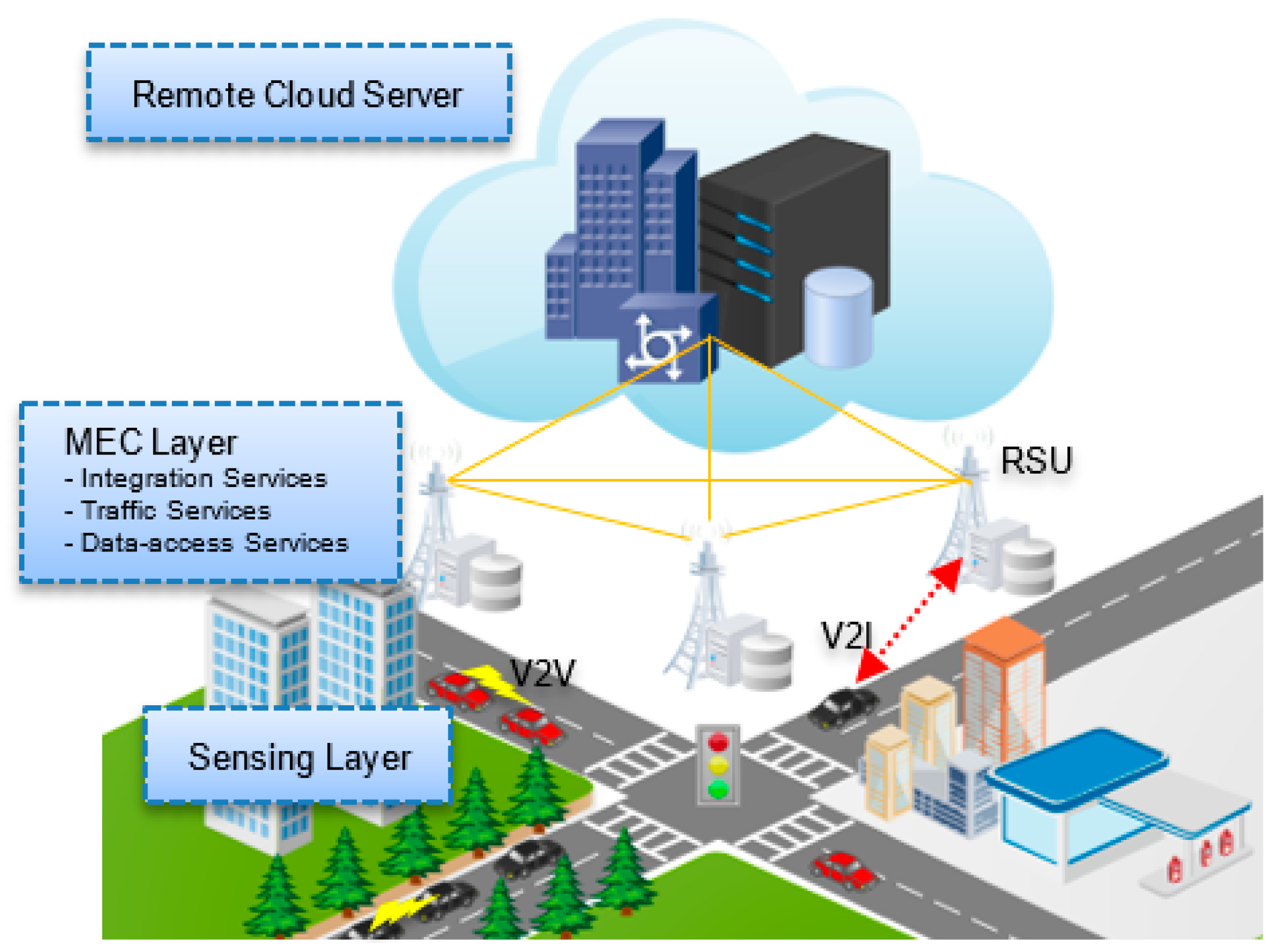
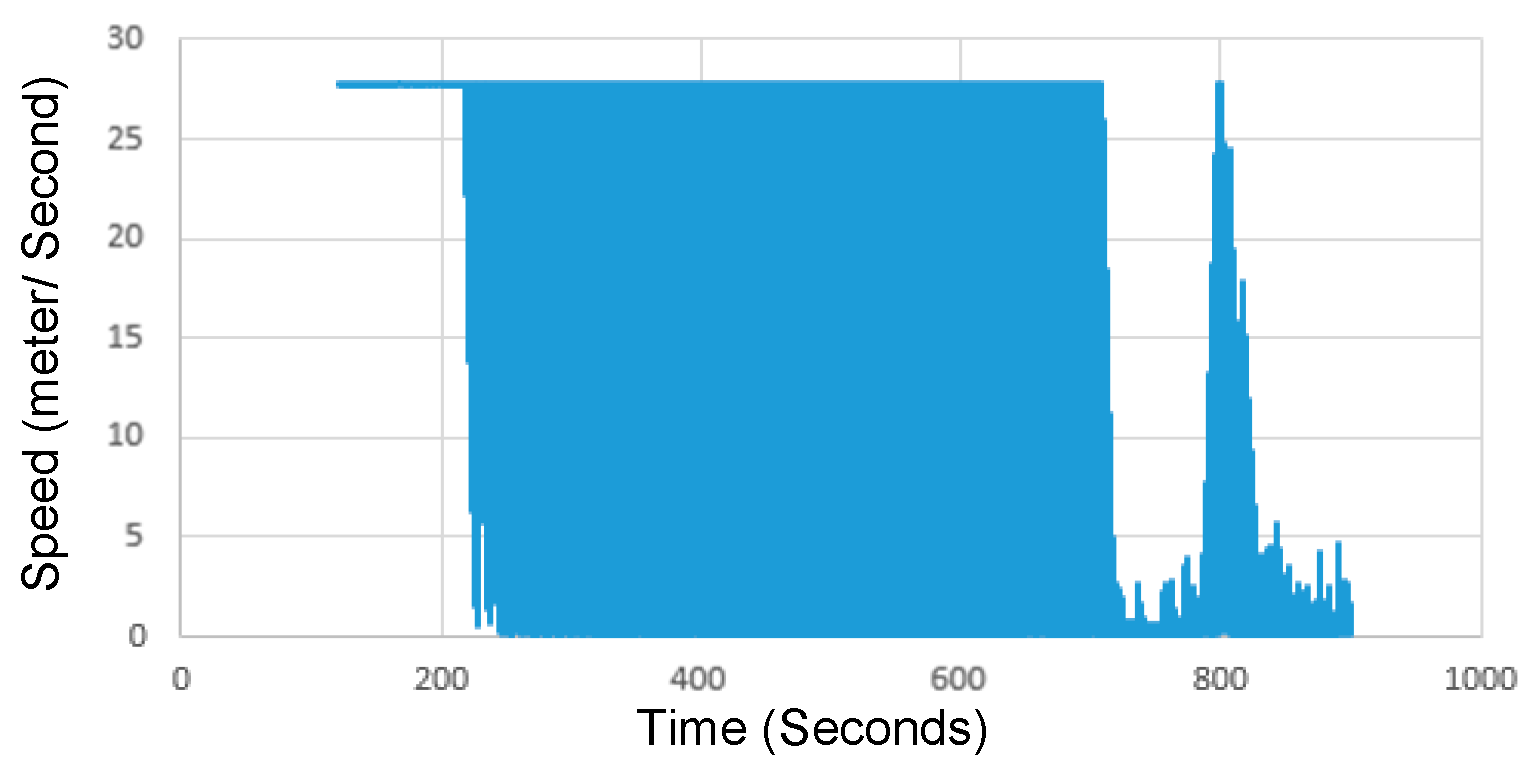
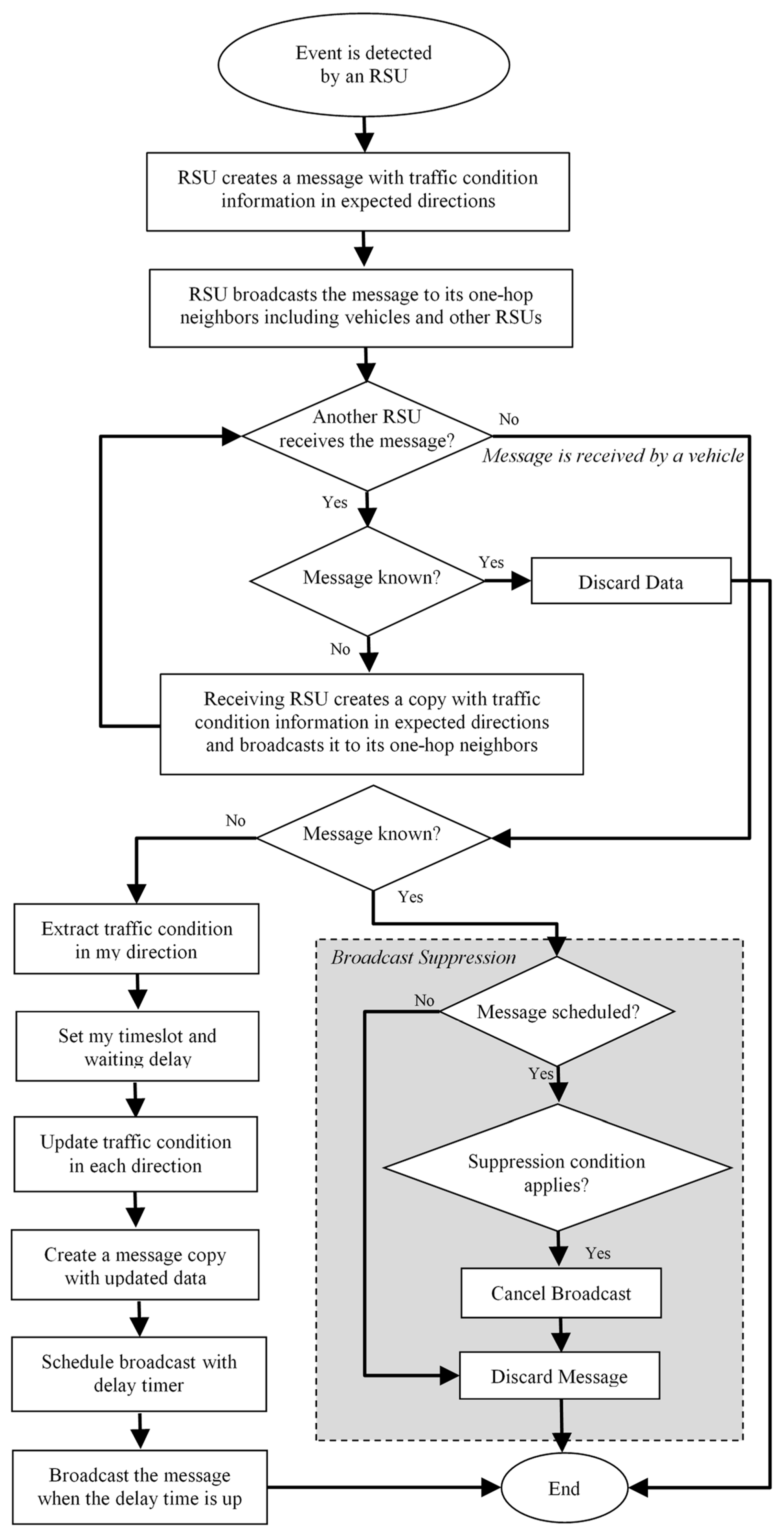
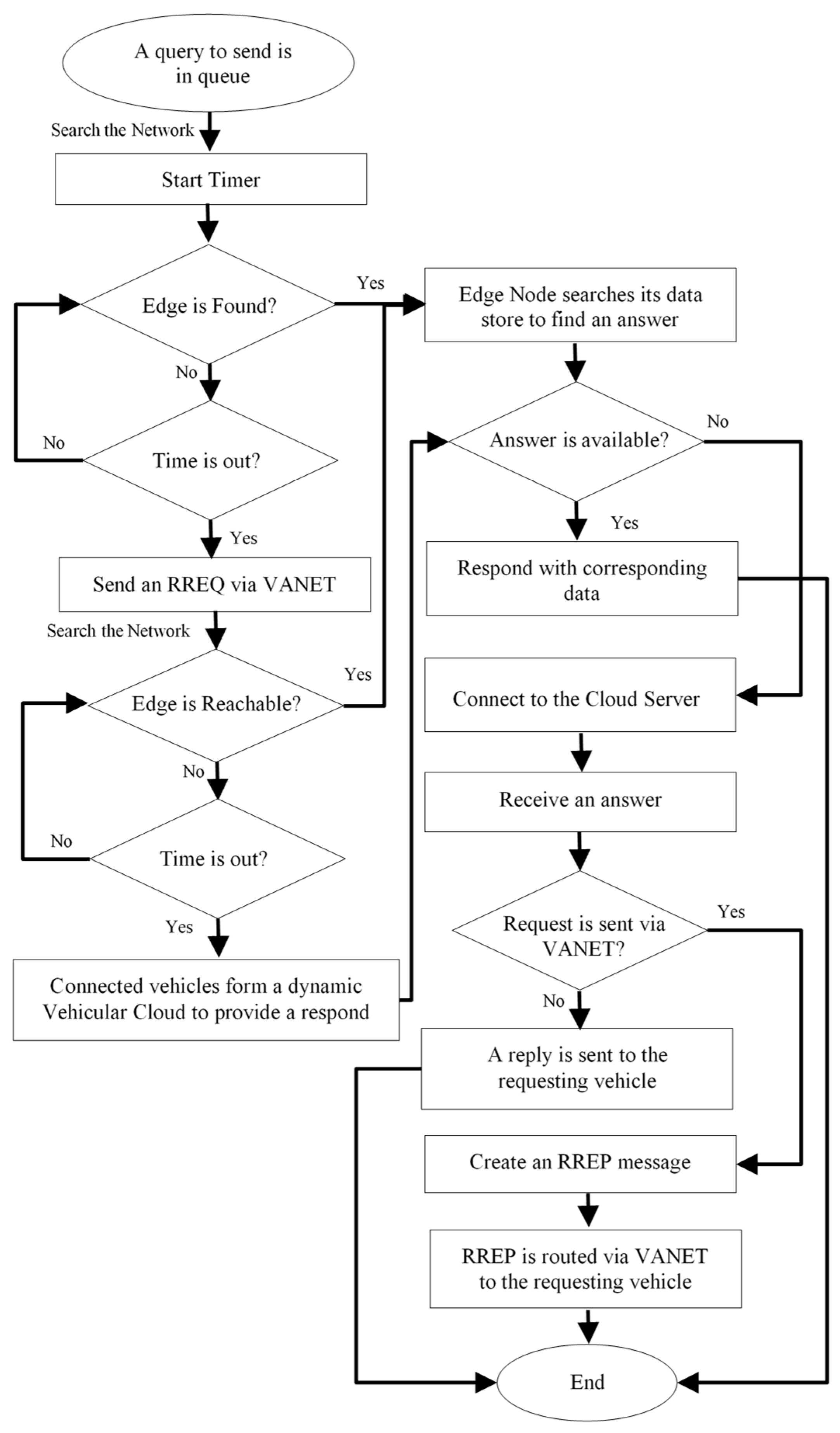
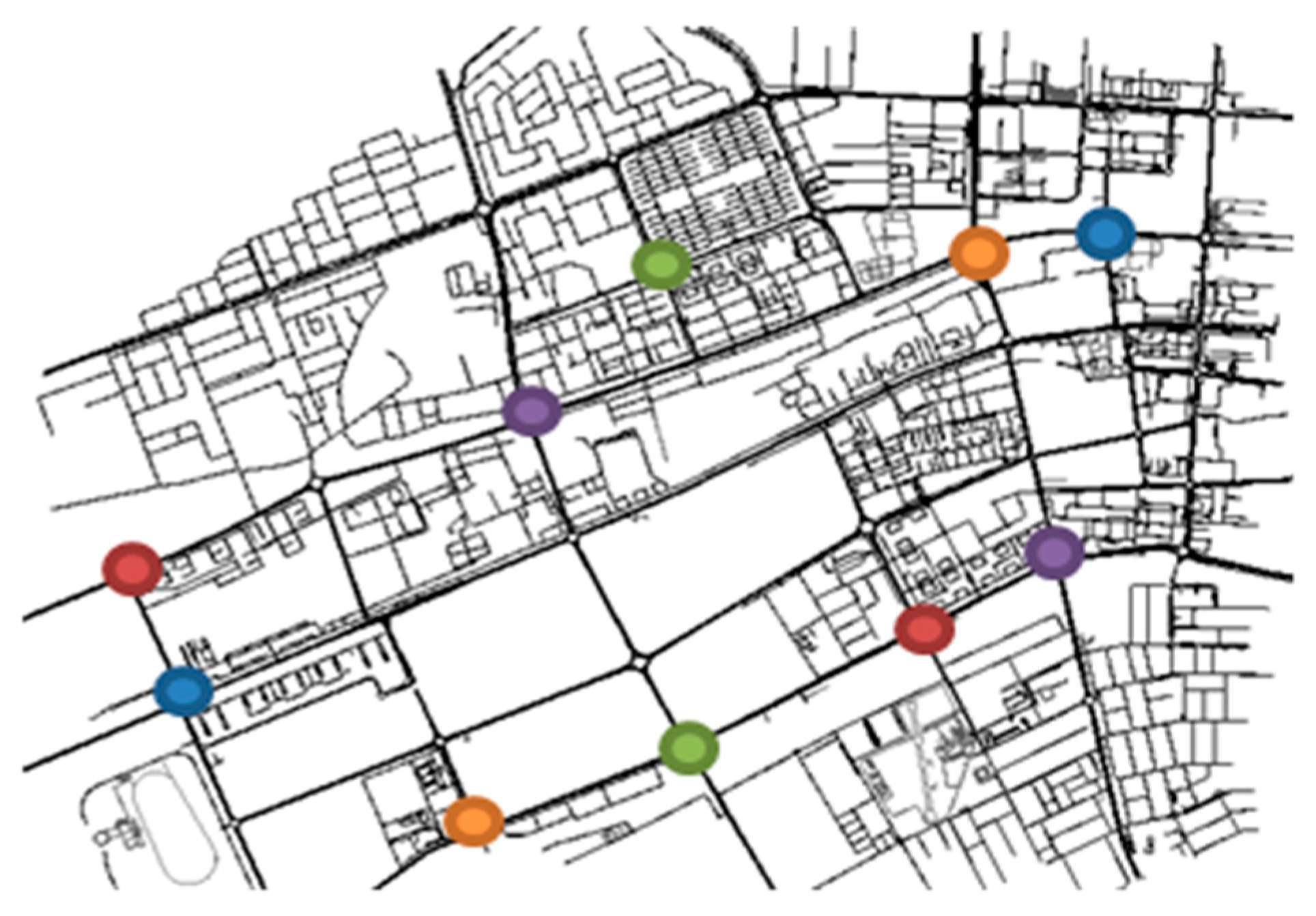

| Physical Layer | Frequency Band | 5.9 GHz |
| Bandwidth | 10 MHz | |
| Radio Range | ~360 m | |
| MAC Layer | MAC Bit Rate | 6 Mbps |
| Mac Delay | 20 ms | |
| Data Frequency | 5 Hz | |
| Scenario | Urban Area | Al Ain city |
| Area of Interest | 6500 × 4000 m | |
| Max. speed | 100 | |
| Message Size | 100 byte | |
| # of Messages | 10 | |
| Simulation time | 900 s | |
| Number of runs | 5 | |
| Confidence Level | 95% | |
| Traffic Flow Rates | {2000, 4000, 6000, 8000} Vehicle/hr. |
© 2019 by the authors. Licensee MDPI, Basel, Switzerland. This article is an open access article distributed under the terms and conditions of the Creative Commons Attribution (CC BY) license (http://creativecommons.org/licenses/by/4.0/).
Share and Cite
El-Sayed, H.; Chaqfeh, M. Exploiting Mobile Edge Computing for Enhancing Vehicular Applications in Smart Cities. Sensors 2019, 19, 1073. https://doi.org/10.3390/s19051073
El-Sayed H, Chaqfeh M. Exploiting Mobile Edge Computing for Enhancing Vehicular Applications in Smart Cities. Sensors. 2019; 19(5):1073. https://doi.org/10.3390/s19051073
Chicago/Turabian StyleEl-Sayed, Hesham, and Moumena Chaqfeh. 2019. "Exploiting Mobile Edge Computing for Enhancing Vehicular Applications in Smart Cities" Sensors 19, no. 5: 1073. https://doi.org/10.3390/s19051073
APA StyleEl-Sayed, H., & Chaqfeh, M. (2019). Exploiting Mobile Edge Computing for Enhancing Vehicular Applications in Smart Cities. Sensors, 19(5), 1073. https://doi.org/10.3390/s19051073





